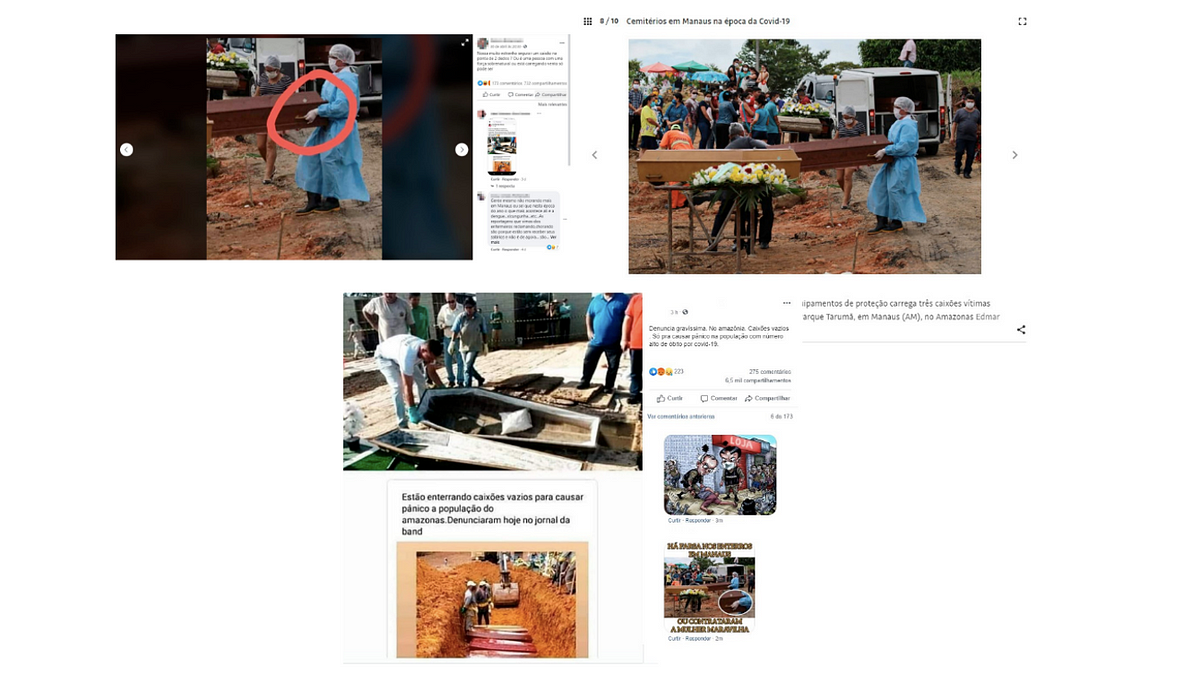Empty hospitals, fake burials and chloroquine: systemic disinfo downplays COVID-19…
Disinfo aligns with President Bolsonaro’s public
Empty hospitals, fake burials and chloroquine: systemic disinfo downplays COVID-19…

Disinfo aligns with President Bolsonaro’s public pronouncements as COVID cases surge to second highest in the world

As Brazil surged to second place in confirmed COVID-19 cases worldwide, internet users in the country have been constantly bombarded with messages downplaying the pandemic. These messages misleadingly suggested that hospitals were empty and coffins were buried with no corpses inside them, as well as that chloroquine and hydroxychloroquine were proven cures to COVID-19.
Although it is not always possible to identify who created these narratives, it is clear that they reinforce the position of the country’s president, Jair Bolsonaro, who has dismissed COVID-19 as a “little flu” and said that strict social isolation measures would harm the country’s economy.
Brazil has been dealing with an economic crisis since 2014, and analysts claim that Bolsonaro fears his popularity could be affected by a deepening of this crisis. Yet polls suggest that his approach to the pandemic, as well as an ongoing political crisis, is affecting his approval rates. In February 2020, 26 percent of the population disapproved of his government; by late May, 50 percent do.
As of May 25, Brazil had 363,211 COVID-19 cases and 22,666 deaths. The federal government has not imposed any national social distancing restrictions, instead insisting on treatment with chloroquine, a drug with adverse side effects that has not yet been proven to be effective. Meanwhile, some states and municipalities have adopted harsh measures to try and stop the number of cases, while others have seen rallies in support of Bolsonaro and the reopening of the economy.
False claims, false narrative
The DFRLab has already reported that articles profiling people that had recovered from COVID-19 were among the most popular in Brazil. These messages, despite not being false, were being pushed by pro-Bolsonaro groups on Facebook, reinforcing the false narrative that the novel coronavirus is not so serious.
Alongside these messages, disinformation is also circulating in Brazil. Claims about empty hospitals, for instance, started to circulate in April, after the president himself claimed he did not know of “any crowded hospitals” in the country and that the virus was not as bad as media portrayed it. While hospitals were still not crowded at that point in time, state governments were already building field hospitals to deal with the expected increased demand. In his statement, Bolsonaro also mentioned one specific hospital and incorrectly downplayed how many patients were being treated there.
A few days later, fact-checking outlets in Brazil verified similar claims about allegedly empty hospitals. Videos published on Facebook showed people in at least three different states (São Paulo, Rio de Janeiro, and Ceará) claiming they were at hospitals and could see that they were empty. The allegations were false, according to Agência Lupa, as all of these hospitals had patients at the time the claims were spread. By the time the rumor was verified, it had been shared more than 27,000 times.

Disinformation also intermingled with the president’s statements in the case of false messages claiming the police were arresting people that disrespected social isolation rules. Although there were some cases of detentions (some due to disrespect of social isolation rules, and some due to disrespect of authorities, a crime in Brazil), the idea that people were being arrested for breaking social isolation was bolstered by false messages. Videos of people being detained in situations that were not connected to COVID were shared as if they pictured COVID-related measures. Some posts used hashtags asking Bolsonaro to “help its people.” In a meeting with its ministers, Bolsonaro complained about the detentions, suggesting that they were unfair and demanded that the justice minister (who left the government amid the political crisis) respond to them.
In late April, as deaths began to soar, disinformation moved from hospitals to cemeteries. As cases surged in Manaus, a city in the heart of the Amazon that had to open mass graves to bury its dead, messages wrongly claimed that coffins were being buried without corpses. Old images of pictures with bags of sand in coffins were used to claim the crisis did not exist, as was as a cropped image that suggested a coffin was empty because a person was carrying it with only two fingers. (The coffin was actually supported by a metallic structure.) These false messages also circulated in other cities and states in Brazil.

Among the misleading narratives about COVID-19, the most impactful one was probably the claim that chloroquine and hydroxychloroquine were cures to COVID-19. The medications started being discussed in Brazil after U.S. President Donald Trump began touting them.
According to research by the CoronaVirusFacts/DatosCoronaVirus alliance, the first mention of chloroquine in Brazil occurred on March 20. After that, false messages with this narrative boomed: some claimed the FDA recommended the treatment for all patients in the U.S. or that studies showed its effectiveness as a treatment, while others showed patients recovering after being treated with the medication. There were messages falsely attributed to judges in which they allegedly said that opposition politicians did not want to approve chloroquine because it prevented them from embezzling money; accusations that pro-social isolation governors were hiding chloroquine from the population; and that there was a conspiracy to undermine chloroquine in favor of the drug Remdesivir, also used experimentally against COVID.
Bolsonaro adopted the idea that chloroquine was a silver bullet, connecting it to the possibility of reopening the country and the economy. Two health ministers left the government amid the pandemic over a disagreement about the use of the medication. On May 19, with an interim minister, Brazil’s health ministry changed its protocol to indicate the use of chloroquine for mild cases despite its potential side effects. There is increasing evidence, however, that the drug does not work against COVID-19; the World Health Organization halted trials with the drug over fear of its side effects.
Luiza Bandeira is a Research Associate, Latin America, with the Digital Forensic Research Lab.
Follow along on Twitter for more in-depth analysis from our #DigitalSherlocks.

